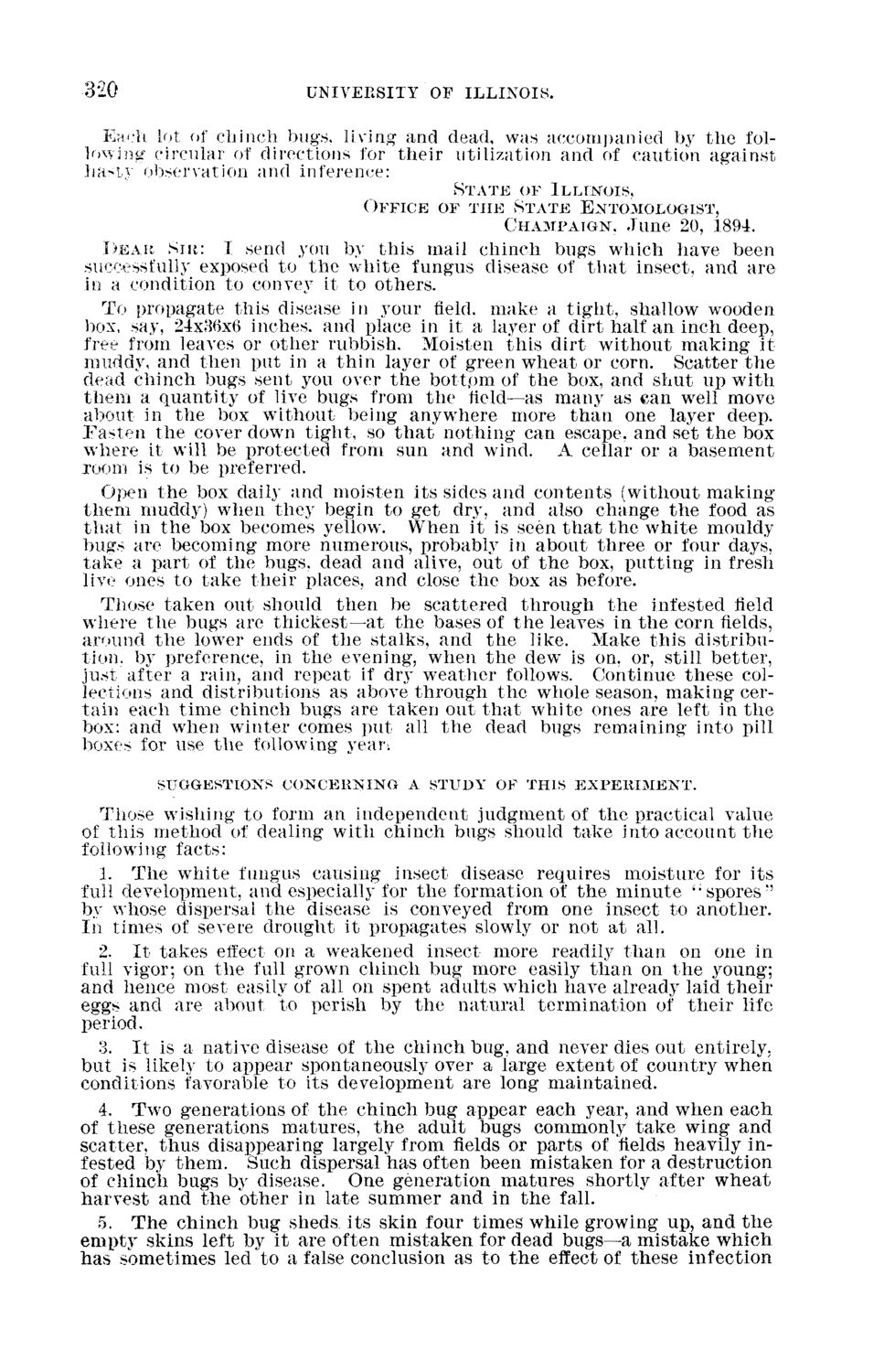| |
| |
Caption: Board of Trustees Minutes - 1894
This is a reduced-resolution page image for fast online browsing.

EXTRACTED TEXT FROM PAGE:
320 UNIVERSITY OF ILLINOIS. Each lot of chinch bugs, living and dead, was accompanied by t h e following circular of directions for their utilization and of caution against hasty observation and inference: STATE OF ILLINOIS, O F F I C E OF THE STATE ENTOMOLOGIST, CHAMPAIGN, J u n e 20, 1894. DEAR SIR: I send you by this mail chinch bugs which have been successfully exposed to t h e white fungus disease of t h a t insect, and are in a condition to convey it to others. To propagate this disease in your field, make a tight, shallow wooden box, say, 24x36x6 inches, and place in it a layer of dirt half an inch deep, free from leaves or other rubbish. Moisten this dirt without making it muddy, and then put in a thin layer of green wheat or corn. Scatter t h e dead chinch bugs sent you over the bottpm of the box, and shut up with them a quantity of live bugs from the field—as many as ean well move about in the box without being anywhere more than one layer deep. Fasten the cover down tight, so t h a t nothing can escape, and set t h e box where it will be protected from sun and wind. A cellar or a basement room is to be preferred. Open the box daily and moisten its sides and contents (without making them muddy) when they begin to get dry, and also change t h e food as that in t h e box becomes yellow. When it is seen t h a t t h e white mouldy bugs are becoming more numerous, probably in about three or four days, take a part of the bugs, dead and alive, out of t h e box, putting in fresh live ones to take their places, and close the box as before. Those taken out should then be scattered through t h e infested field where the bugs are thickest—at the bases of t h e leaves in t h e corn fields, around t h e lower ends of the stalks, and t h e like. Make this distribution, by preference, in the evening, when the dew is on, or, still better, just after a rain, and repeat if dry weather follows. Continue these collections and distributions as above through the whole season, making certain each time chinch bugs are taken out t h a t white ones are left in t h e box: and when winter comes put all t h e dead bugs remaining into pill boxes for use t h e following year. SUGGESTIONS CONCERNING A STUDY OF THIS E X P E R I M E N T . Those wishing to form an independent judgment of t h e practical value of this method of dealing with chinch bugs should take into account t h e following facts: 1. The white fungus causing insect disease requires moisture for its full development, and especially for the formation of t h e minute '-spores"' by whose dispersal t h e disease is conveyed from one insect to another. lit times of severe drought it propagates slowly or not at all. 2. I t takes effect on a weakened insect more readily than on one in full vigor; on the full grown chinch bug more easily than on t h e young; and hence most easily of all on spent adults which have already laid their eggs and are about to perish by t h e natural termination of their life period. 3. I t is a native disease of t h e chinch bug, and never dies out entirely, but is likely to appear spontaneously over a large extent of country when conditions favorable to its development are long maintained. 4. Two generations of the chinch bug appear each year, and when each of these generations matures, t h e adult bugs commonly take wing and scatter, thus disappearing largely from fields or parts of fields heavily infested by them. Such dispersal has often been mistaken for a destruction of chinch bugs by disease. One generation matures shortly after wheat harvest and the other in late summer and in t h e fall. 5. The chinch bug sheds its skin four times while growing up, and t h e empty skins left by it are often mistaken for dead bugs—a mistake which has sometimes led to a false conclusion as to t h e effect of these infection
| |